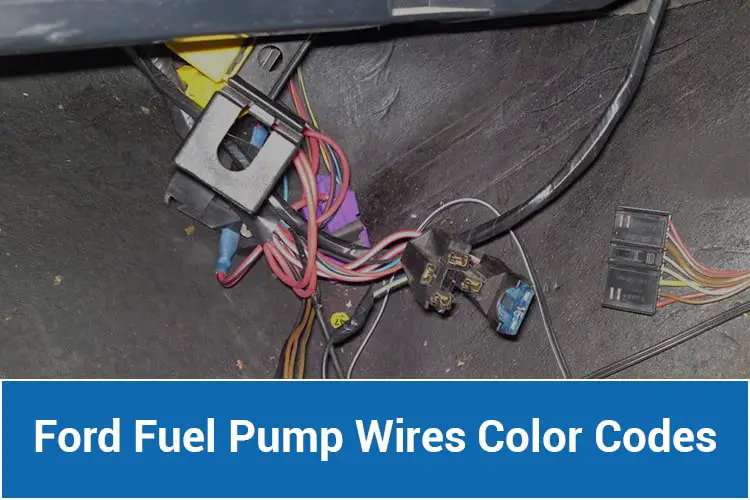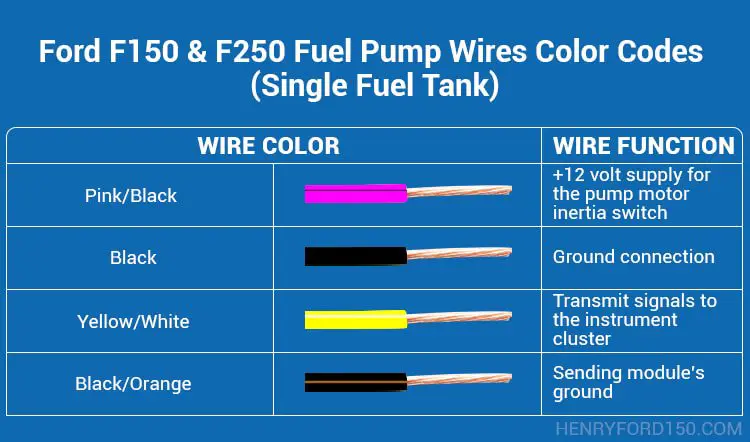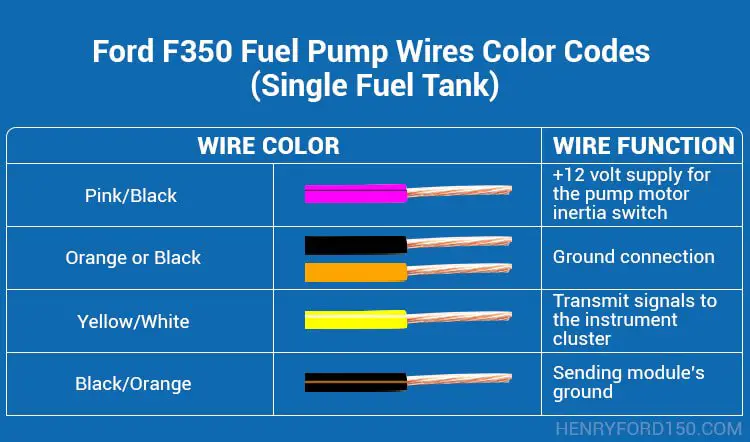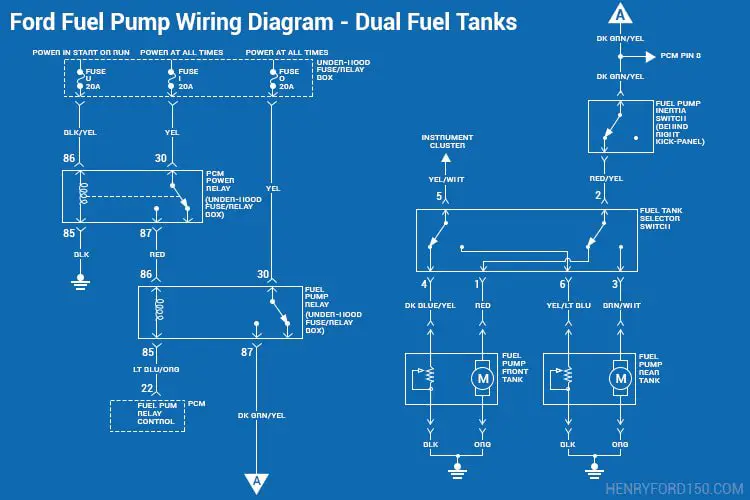You should know the Ford fuel pump wires color codes before performing any DIY repairs on the wiring. This is because the fuel pump is an important part of your vehicle’s fuel injection system. It will be challenging to connect the wires without technical knowledge of the color scheme.
My guide contains sections stating the fuel pump wires color codes for Ford F150, F250, and F350.
Also, expect to see answers to frequently asked questions related to the topic as you approach the end of this article.

Ford F150 Fuel Pump Wires Color Codes (Single Fuel Tank)
All F150 trim levels use the same type of fuel pumps. See the F150 Ford wiring color codes below.
Pink/Black
It gives your truck’s pump motor inertia switch a +12-volt supply.
Black
It provides the return passage of the motor’s electrical current or supplies ground connection. The circuit has a 20 amp fuse and fuel pump relay to direct the operation of the pump from the powertrain control module (PCM) and protect it.
Yellow / White and Black / Orange
The fuel pump features a sending module that measures the tank’s fuel level. The unit also transmits signals for the fuel level to be displayed on the dash. Your F150 fuel pump’s wiring harness has two cables dedicated to the sending unit. A yellow/white cable transmits signals to the dashboard’s instrument cluster to display fuel level, while a black / orange cable is the sending module’s ground.
Note: Aftermarket fuel pump wiring color codes are different.
Ford F250 Fuel Pump Wires Color Codes (Single Fuel Tank)
The Ford F250 offers dual and single fuel tank options. The single fuel tank option bears similarities to that of the Medium-Duty option of the F150, including fuel pump wires color codes.

Ford F350 Fuel Pump Wires Color Codes (Single Fuel Tank)
The F350 single fuel tank has four wires (two for the fuel level sender module), as explained below.
Black-Striped Pink
This wire carries 12 volts of power. It gets heated when cranking your engine to start.
Orange
The orange cable is the ground for the wiring.
Yellow/White
It enables the dashboard’s instrument cluster to show your truck’s fuel levels.
Black/Orange
This links the ground in completing the sender unit’s circuit. There is a relay unit pump relay that triggers it to turn on and off in line with the signal sent by the PCM when the engine is started.
Read more: Ford F150 Radio Wiring Harness Diagram

Ford Fuel Pump Wires Color Codes for Vehicles with Dual Fuel Tank
Ford trucks also have dual fuel tanks, apart from single fuel tanks. The vehicle having dual fuel tanks means that there are two fuel pumps. You can choose between any of the two fuel pumps using the dashboard’s selector switch.

Fuel Pump Relay
The unit has four colored wires, as described below.
Red
This cable gets the power to the relay coil from the PCM.
Yellow
It is linked to a 20 amp fuse.
Deep Green/Yellow
The deep green/yellow wire is a typically open relay contact powered when the engine is working. It gets 12 volts.
Light Blue/Orange
It is a PCM relay control cable that transmits signals to a relay coil for de-energizing or energizing.
Selector Switch for the Fuel Tanks
This switch is located inside the vehicle’s cabin on the driver’s side. It lets you choose between the rear or front tank with six cables to control its workings, as described below.
Red
This wire switches the pump of the front tank on.
Brown/White
It powers the rear tank pump.
Yellow/Light Blue
This is for the rear tank’s sender module.
Deep Blue/Yellow
It is for the front tank’s sender unit.
Yellow/White
It connects the dashboard’s instrument cluster to the front and rear sender units based on the chosen tank.
Red/Yellow
The red/yellow cable obtains +12 volts from the fuel pump relay. It is attached to the inertia switch.
Fuel Pump of the Front Tank
There are four wires for this fuel pump and the sender unit, as explained below.
Red
It sends power to the fuel pump.
Orange
This aids the pump ground in finishing its circuit.
Deep Blue/Yellow
The deep blue/yellow cable links the dashboard’s instrument cluster with the fuel level sender module.
Black
This is the ground wire, facilitating a return passage for the sender unit’s current.
Fuel Pump of the Rear Tank
Brown/White
It is for supplying +12 volts of power via the same passage as the front fuel pump.
Orange
This is the ground to the brown/white cable.
Yellow/Light Blue
It carries return signals from the fuel level sender module to the instrument cluster.
Black
This is the ground to the yellow/light blue cable.
Read more: F150, F250, F350 & Raptor Rooftop Tent: Here Are The Best Options
Ford Fuel Pump Wires Color Codes – FAQs
How Do You Hotwire a Ford Fuel Pump?
Ford fuel pump hotwiring can be done in the following ways:
- Using a self-test connector
The point for the fuel pump test in the self-test connector is circuit 926 (an orange-striped light blue wire). Start the process by grounding that point. Switch the ignition on after to make the fuel pump relay start working. This will make the fuel pump the vehicle’s tank switch selected to turn on.
- Jumping Pin 2 to Pin 6
Use a self-test plug to jump pin 2 to pin 6. The issue may be ground-related, provided that you did the jump and the pumps weren’t activated even with power being at the switch. The fuel pumps and senders are attached to ground G100, which can be found on the radiator support (driver’s side).
What Sends Power to the Fuel Pump?
A vehicle’s fuel pump is powered by its battery via a sequence of parts and their links. The process starts from the pump’s fuse and continues through the ignition switch, ECM (engine control module) relay, ECM, and fuel pump relay.
What Happens When a Fuel Pump Is Wired Wrongly?
A fuel pump won’t be activated or won’t supply adequate fuel to the engine if it isn’t properly installed. The engine may run rough or fail to start up—or it will lose fuel efficiency and power.
What Fuse Goes to the Fuel Pump?
The fuse that goes to the fuel pump is typically a 15 (blue), 25 (clear), or 20 (yellow).
How Do You Test a Fuel Pump Wire?
Follow the steps below to test the fuel pump wire.
Step 1: Detach the connector pins on top of the pump.
Step 2: Use a multimeter to assess the voltage of the ground and power terminals. The problem may be a damaged wire if the reading indicates 0 volts instead of 12 volts at the fuel pump terminal.
Do the following to be sure that the fuel pump isn’t receiving power:
Step 1: Link the multimeter’s negative lead to a well-functioning ground in the vehicle frame.
Step 2: Attach the positive lead to the fuel pump’s power terminal. The fuel pump isn’t receiving power if you get a reading of 0 volts.
A corroded terminal will cause the voltage to drop across the terminals. Your multimeter will indicate 10 volts or 9 volts in place of 12 volts. You will know it is a corroded terminal when the voltage drop is more than 1 volt.
Final Thoughts
Figuring out the fuel pump wires color codes of your Ford F150, F250, and F350 should be easy with this guide. Let an expert handle the repair work if you still find the unit’s wiring confusing. You may end up creating another problem if you get the connection wrong.
Finally, at least one article clarified the color code of the car wires, as for a girl – this is a useful article and information. The FAQ section added even more information, thanks for such detailed information, I also really like the https://truckgift.com/ page – you can visit it and read a lot of useful information on automotive topics
Thank you for visiting! Just take a look at Truckgift.com. It is great – thanks for your recommendation.
Thank youu! I’ve been dealing with this issue on my 1992 Ford f150 for too long! And spent a lot of time on the side of the freeway trying to limp home. This was clear and easy for me to understand. I appreciate you. Now im going to get under that truck and see what I’ve been doing wrong. I trust that I’ll get it right finally.
Hi Mark. Thank you for your heartfelt comment! I’m confident that armed with the information from the article, you’ll be able to tackle the fuel pump wires issue on your 1992 Ford F150. You’ve got this! If you have any more questions or need further assistance, feel free to ask. Best of luck with your repair, and I’m here to support you every step of the way!
holy cow it took forever to find this information. even the repair manual doesn’t talk about the details on this model of truck. thank you so much and now I’m finally able to drive without worry of running out of gasoline.